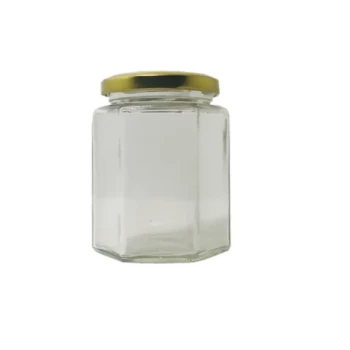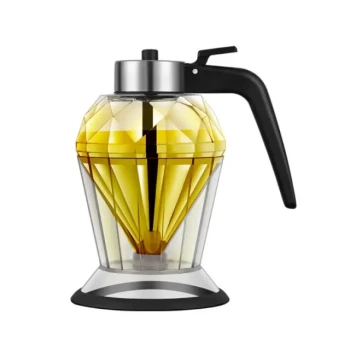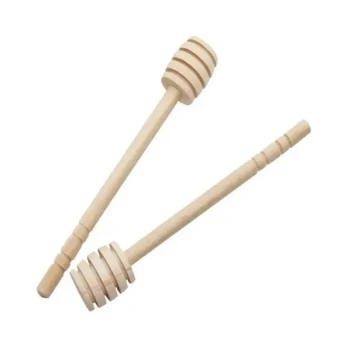In short, the most common types of honey packaging are glass jars, plastic bottles (including squeeze bottles), flexible pouches or sachets, and metal tins. Each format serves a distinct purpose, balancing factors like product protection, brand perception, user convenience, and cost.
The right honey packaging is more than a simple container; it is a strategic decision that defines your brand and meets specific consumer needs. Your choice directly communicates product quality, influences user experience, and impacts overall production and shipping costs.
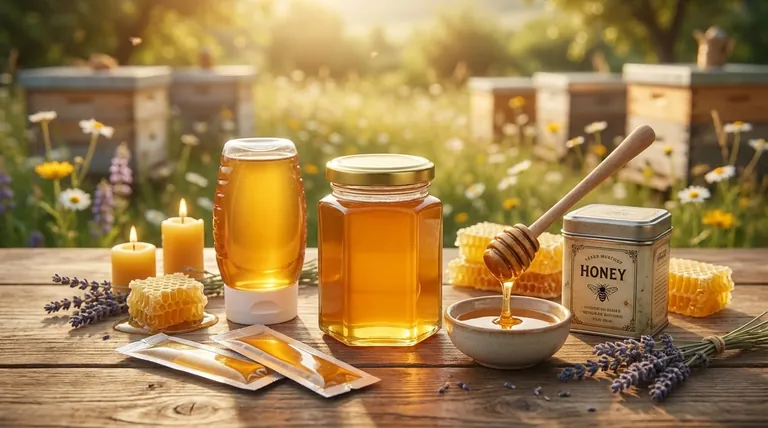
The Purpose of Honey Packaging
Before choosing a container, it is critical to understand the role packaging plays. It is not just about holding the honey; it's a technical system designed to protect and present the product effectively.
Protecting Against Spoilage
Honey's low moisture content makes it naturally resistant to spoilage, but it is hygroscopic, meaning it will absorb moisture from the air. Proper packaging creates an airtight seal that prevents the absorption of moisture and protects against environmental contaminants.
Retaining Natural Aroma and Flavor
A well-sealed container is essential for preserving honey's delicate and unique flavor profile. It prevents the natural aroma from dissipating and stops the honey from picking up odors from its surroundings.
Meeting Consumer Expectations
Modern consumers expect to see the product they are buying. Transparent packaging, like glass or clear plastic, allows the honey's color and clarity to be showcased. Increasingly, customers also value sustainable options, making recyclability a key consideration.
A Breakdown of Common Packaging Types
Each packaging material offers a distinct set of benefits tailored to different markets, price points, and use cases.
Glass Jars and Bottles (The Premium Standard)
Glass is the traditional and often premium choice for honey packaging. Classic shapes like the queenline jar are instantly recognizable to consumers.
Being chemically inert, glass does not interact with the honey, ensuring the flavor remains completely unaltered. It is also impermeable to gases and moisture, offering the best possible long-term protection.
Plastic Bottles and Jars (The Versatile Workhorse)
Plastic, particularly PET (polyethylene terephthalate), is valued for its versatility, durability, and light weight. These characteristics make it less expensive to ship and more resistant to breakage than glass.
The most popular format in this category is the squeeze bottle. Its user-friendly design allows for clean, precise dispensing, making it a favorite for family and daily use.
Flexible Pouches and Sachets (The Convenient Option)
This category includes single-serving stick packs and tear-off pouches. These are produced by filling and sealing honey into rolls of film, which are then cut into individual units.
They are ideal for on-the-go consumption, food service applications, or product samples. Their primary benefits are portability, portion control, and low material usage per unit.
Metal Tins (The Niche Classic)
Though less common today, metal tins offer a classic, vintage appeal. They provide excellent protection from light, which can degrade honey over time.
Their primary drawback is that they are opaque, preventing customers from seeing the product. They are most often used for specialty or gift-marketed honey.
Understanding the Trade-offs
No single packaging type is perfect for every situation. Your choice involves balancing cost, branding, and functionality.
Glass: Perceived Quality vs. High Cost
Glass signals a high-quality, pure, and artisanal product. However, it is the heaviest and most fragile option, leading to higher costs for both the material and shipping.
Plastic: Affordability vs. Brand Perception
Plastic is a cost-effective, durable, and lightweight choice perfect for mass-market distribution. While highly functional, it may not convey the same premium, all-natural image as glass.
Pouches: Portability vs. Long-Term Protection
Flexible pouches excel in convenience and single-use scenarios. However, the thinner film material typically offers less robust protection against oxygen and moisture compared to rigid glass or plastic, making it less suitable for long-term storage.
Making the Right Choice for Your Brand
Your packaging decision should align directly with your business goals and target audience.
- If your primary focus is a premium, artisanal brand: Glass jars are the definitive choice to communicate superior quality and preserve nuanced flavors.
- If your primary focus is broad retail distribution and user convenience: Plastic squeeze bottles offer the best balance of low cost, durability, and a positive user experience.
- If your primary focus is food service or on-the-go products: Single-serve pouches and stick packs provide unmatched portability and portion control.
- If your primary focus is minimizing initial costs and weight: Standard PET plastic jars are the most economical option for both production and shipping.
Ultimately, your packaging is the first interaction a customer has with your product; choose the option that tells the right story.
Summary Table:
| Packaging Type | Best For | Key Advantage | Key Consideration |
|---|---|---|---|
| Glass Jars | Premium/Artisanal Brands | Superior product protection & quality perception | Higher cost & weight |
| Plastic Bottles | Mass Market/Retail | Lightweight, durable & cost-effective | Less premium brand image |
| Flexible Pouches | Food Service/On-the-go | Portability & portion control | Less suitable for long-term storage |
| Metal Tins | Specialty/Gift Markets | Excellent light protection & vintage appeal | Opaque (product not visible) |
Ready to Package Your Honey Successfully?
Choosing the right packaging is a critical step for your brand's success. HONESTBEE supplies commercial apiaries and beekeeping equipment distributors with the wholesale packaging solutions they need to thrive.
We provide a range of high-quality containers to meet your specific requirements for cost, branding, and functionality. Let us help you find the perfect packaging to protect your product and tell your brand's story.
Contact HONESTBEE today to discuss your wholesale honey packaging needs!
Visual Guide
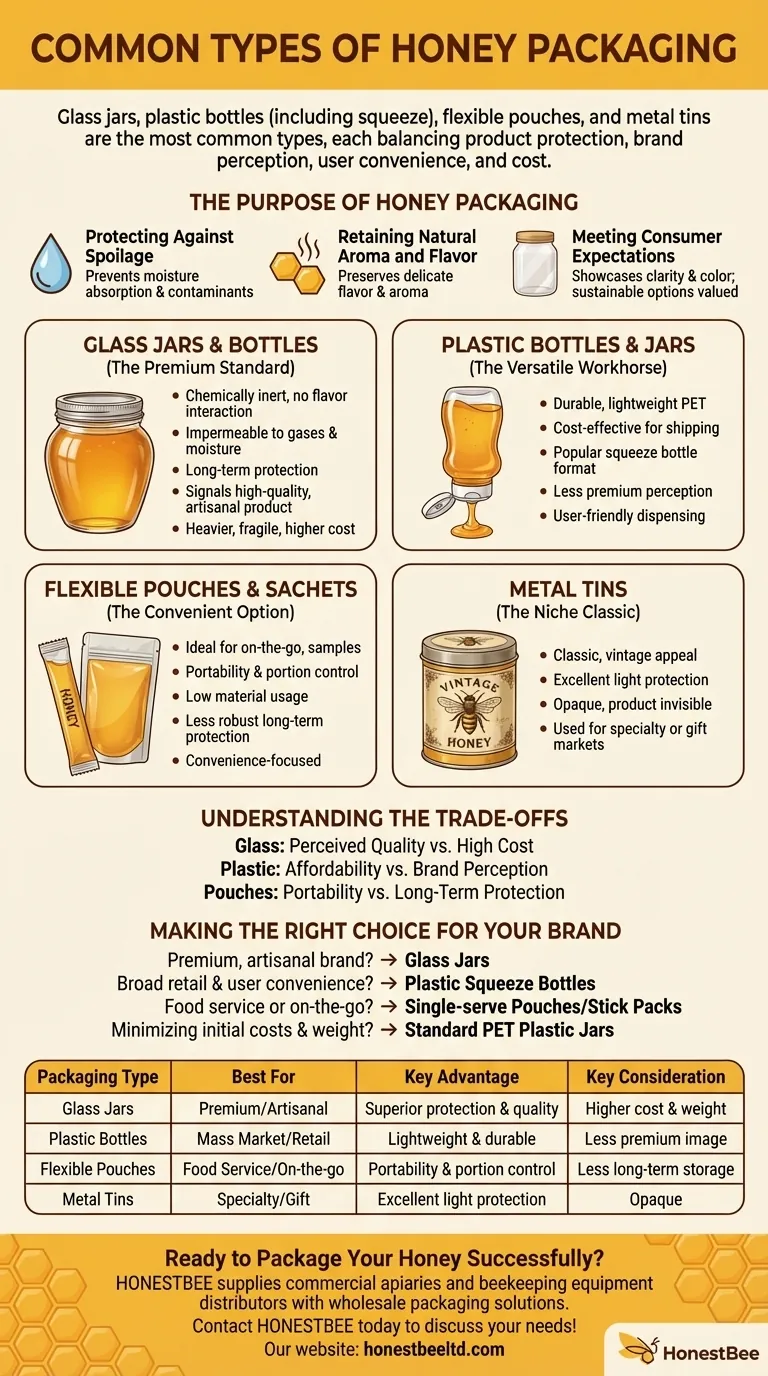
Related Products
- Hexagonal Glass Honey Jars with Metal Lug Caps Elegant Versatile Packaging
- Classic Drum Shaped Glass Honey Jar with Airtight Lid
- Classic Honey Bear Jars with Flip Top Dispensing Cap for Liquid Sweeteners
- Inverted Squeezable Honey Jar with No Drip Flip Top Cap for Easy Pouring
- Pneumatic Double Nozzle Honey Filling Bottling Packaging Machine
People Also Ask
- What is the best way to jar honey? Preserve Quality with the Right Container
- What factors should be considered when choosing honey packaging? Optimize for Brand, Operations & Market
- How many jars of honey do you get from a hive? Unlock Sustainable Harvesting Secrets
- How should honey be stored and packaged? Preserve Flavor & Quality with Proper Containers
- What is the term for honey can absorb moisture from the air? Understanding Hygroscopy
